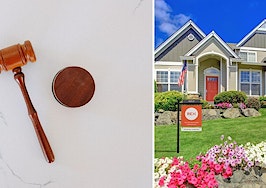No one can predict the future of real estate, but you can prepare. Find out what to prepare for and pick up the tools you’ll need at Virtual Inman Connect online Nov. 1-2, 2023. And don’t miss Inman Connect New York on Jan. 23-25, 2024, where AI, capital and more will be center stage. Bet big on the future and join us at Connect.
The vast majority of local Realtor associations have fewer than 2,000 members, maintain less than two years of reserves, and draw on late fee penalties as their most common source of non-dues revenue, according to an inaugural report from the National Association of Realtors released Wednesday.
NAR boasts 1,057 local Realtor associations and 54 state Realtor associations, including those for Puerto Rico, Guam and the Virgin Islands. The report, NAR’s 2023 Association Profile, looked at how local Realtor associations of different sizes operate and compare to each other. NAR fielded the survey in June via email and received responses from 292 association executives. The results’ confidence interval at a 95 percent level of confidence is +/-4.8 percent.
TAKE INMAN’S INAUGURAL SURVEY ON AGENT COMMISSIONS
NAR has 1.56 million members. The report found that 74 percent of local Realtor associations have less than 2,000 members each: 38 percent that have between 500 and 1,999 members (“medium” associations) and 36 percent that have fewer than 500 members (“small” associations). Separately, NAR told Inman that 143 associations — 13.5 percent — have fewer than 100 members.
Only 10 percent of local Realtor associations have more than 7,000 members (“mega” associations) while 16 percent have between 2,000 and 6,999 members (“large” associations).
Overall, 74 percent of local associations own 100 percent of their local multiple listing service with the share at 100 percent among mega associations and declining steadily by association size (69 percent for small associations), according to the report. Twelve percent of associations overall are shareholders of their local MLS.
Among associations’ MLSs overall, 38 percent allow non-Realtors to join the MLS. Mega and large associations were the most likely to allow non-Realtor participation (54 percent and 61 percent, respectively) while medium and small associations were the least likely (39 percent and 21 percent, respectively).
When it comes to a financial safety net, 7 percent of associations maintain more than five years of financial reserves while 9 percent maintain between three and five years of financial reserves. Just under 4 in 10, 39 percent, keep between one and two years of reserves while 33 percent keep between six months and less than one year of reserves. Three percent keep less than six months of reserves.
The vast majority of associations (85 percent) charge their members dues annually, typically in October or November, according to the report. Nearly all local Realtor association respondents, 92 percent, said they solicit contributions for NAR’s political action committee, RPAC, at the same time as dues, “above the line.”
“‘Above the line’ means to solicit for an optional PAC contribution at the same time they do dues billing,” NAR spokesperson Lauren Cozzi told Inman in an emailed statement.
“NAR is not familiar with whether associations request a specific amount, because NAR does not collect/monitor the local boards’ policies and procedures for dues billing; that is the associations’ business. If they solicit for NAR’s PAC or their state’s PAC (several states have their own federal PAC), NAR would not know for what they are asking.”
The vast majority of association respondents, 83 percent, said they either hold or host RPAC fundraising events.
The most common non-dues revenue sources of Realtor associations are penalties through late fees (64 percent), continuing education courses (63 percent), affiliate programs (54 percent) and the local MLS (52 percent).
Asked what kinds of late fees this is referring to and how much of associations’ revenue comes from late fees, Cozzi noted that Realtor associations are not chapters of NAR, but rather their own entities with their own staff, officers, and directors.
“NAR is neither familiar with their sources of revenue, nor with how associations structure their own dues, late fees, etc.,” Cozzi said. “Also, associations are not under any obligation to report that data to NAR.”

Large and medium associations were most likely to cite penalties through late fees as a source of non-dues revenue (67 percent and 72 percent, respectively) while mega associations were the least likely (48 percent). Mega associations were also the least likely to cite the MLS as a source of non-dues revenue (32 percent) while small associations were the most likely to (63 percent).

While Realtor associations overall employed three full-time staff members and one part-time staff member, staffing varied widely by size. Mega associations had a median 17 full-time staffers, large associations a median nine such staffers, medium associations a median three such staffers, and small associations a median one such staffer.
Virtually all local associations, 94 percent, at least employed an association executive or CEO, according to the report. Between 25 percent and 34 percent of associations employed a membership director, government affairs director, education director, and/or a communications director. Virtually none of the small associations employed such directors, only hiring an association executive. At the same time, half or more of the large and mega associations had such directors.
Just over half of associations employed administrative assistants (59 percent) and membership staff (53 percent). Only 7 percent employed legal counsel with mega associations most likely to do so (38 percent) and 6 percent or less of smaller associations doing so.
Just over a fifth of associations, 22 percent, “share staff and services with other Realtor associations to conserve and optimize resources,” the report said.
Virtually all, 95 percent, of associations have a conflict of interest policy, and the vast majority, 81 percent, have a whistleblower policy, according to the report. Only 17 percent have a nepotism policy.
About two-thirds of association respondents (65 percent) have a social media policy or guidelines for staff, 60 percent have them for their board of directors, 49 percent have them for committee members, and 35 percent have them for members. Violations of the policy are dealt with on a case-by-case basis by 67 percent of associations.
Some two-thirds of associations, 66 percent, said they have or participate in a leadership program with 87 percent of mega associations doing so while 60 percent of small associations do.
When it comes to governance, just over half of associations, 56 percent, said they use virtual voting for governance meetings with 76 percent of mega associations doing so while 53 percent of medium and small associations do.
The vast majority of association respondents, 78 percent, said their board members were nominated and voted on by the association’s membership, though this was least likely among mega associations where only 28 percent said this was how their board of directors was selected. Among those mega trade groups, 12 percent said their board members were appointed by elected leadership (compared to 7 percent among associations overall).

A whopping 60 percent of mega associations said they used some other process to choose their board members. Asked for examples of the “other” processes that mega associations use, NAR’s Cozzi said, “NAR cannot and does not dictate how associations elect their chairs, boards, trustees, etc. It’s not part of NAR’s ‘business.’ Association election processes are likely to be dictated within local associations’ bylaws.”
According to the report, Realtor associations are most likely (38 percent) to have a three-year term limit for their board members, followed by a term limit of five or more years (18 percent) and a limit of two years (17 percent). Fifteen percent have no term limit for their board members.
“This varies, however, by association size – Mega associations are most likely to have a 5+ year term limit, compared to a three-year limit among Large, Medium, and Small associations,” the report said.
When it comes to qualifications to be a member of the board of directors, the most common criterion is a minimum tenure as a member of the association (52 percent), followed by a minimum tenure on a committee (41 percent), according to the report. Only 21 percent require that the candidate have real estate as their primary occupation.
The vast majority of Realtor associations (79 percent) do not have additional criteria for to serve in a leadership position and six percent or fewer require a background check, social media audit, or credit check for leadership position participation, according to the report.

Source: NAR 2023 Association Profile
The advocacy efforts Realtor associations are most likely to participate in are fair housing (85 percent), property rights (80 percent), housing affordability (73 percent), and housing production (50 percent), according to the report.
Nearly all, 90 percent, of association respondents reported offering continuing education (CE) courses. Overall, respondents offered a median 20 educational courses with 12 of those being CE courses. The median number of courses varied exponentially by size: a mega association offered a median 60 classes while a small one offered a median six classes.













